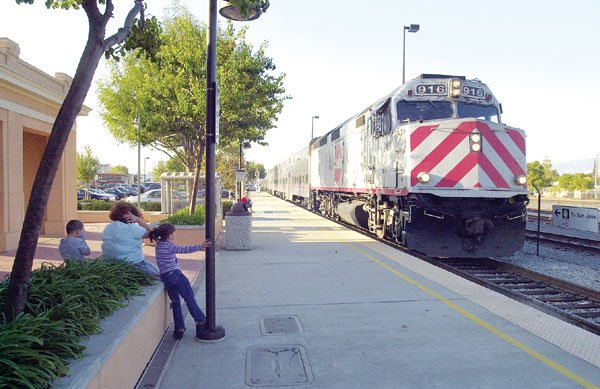SAN JOSE
– Is the planned Bay Area Rapid Transit line to San Jose
realistic anymore?
That’s the hard question Valley Transportation Authority Board
members are asking themselves in light of new revenue projections
that VTA staff say might break BART’s back financially. Without a
new revenue source or a massive economic recovery, staff say the
VTA can’t borrow enough to finish the project.
SAN JOSE – Is the planned Bay Area Rapid Transit line to San Jose realistic anymore?
That’s the hard question Valley Transportation Authority Board members are asking themselves in light of new revenue projections that VTA staff say might break BART’s back financially. Without a new revenue source or a massive economic recovery, staff say the VTA can’t borrow enough to finish the project.
South County Supervisor Don Gage is pushing to freeze $170 million earmarked for engineering the BART extension south from Fremont, through San Jose to Santa Clara. He’d rather cut BART short at Milpitas and see the money spent on other promised rail routes, like light rail to eastern San Jose and improved Caltrain service to Gilroy.
Others, like San Jose Mayor Ron Gonzales, say Gage is overreacting based on pessimistic, recession-based sales-tax revenue estimates and warn that delaying the engineering would make the project unprepared when future funds become available.
Gilroy Mayor and VTA Board member Tom Springer says the South Bay has to build BART if it doesn’t want jobs to flee. California is expected to add 13 million people in the next 20 to 25 years, he said, and if commuting to work in the Bay Area becomes a problem, industry may well move these jobs to the Central Valley.
“If you kill BART, you practically guarantee that jobs go over to the Central Valley,” Springer said this morning. Springer is on the VTA Board until December, in a seat that rotates between Gilroy, Milpitas and Morgan Hill.
On Aug. 7, VTA Board members voted 7-5 to include the BART engineering fees in a $550 million bond.
Poor revenue projections
Within the last few weeks, however, VTA staff have revised their revenue projections. When voters overwhelmingly approved the sales tax hike in 2000, it was at the peak of an unprecedented boom for the Bay Area. Now, in the middle of a lengthy recession, the expectation of nearly $6 billion from Measure A has dropped. The VTA is now using an admittedly conservative estimate of less than $4 billion. Building the BART extension – let alone operating it – is projected to cost $4.6 billion to $6.5 billion, depending on how long it has to be delayed. A quicker timetable would be cheaper, but the VTA then runs into the cash-flow problem of not being able to borrow enough money.
Based on these forecasts, the VTA says it couldn’t do what’s expected of it without more money.
And where would more money come from? There’s been talk of another half-cent sales tax hike for BART on the 2004 ballot, or extending the current one farther. Taxing the problem into submission may be problematic with voters, however, partly because the recession might not have lifted in time for a 2004 vote and partly because there’s also talk of yet another half-cent sales tax to save existing VTA bus and light-rail operations, which are running with a $100 million annual deficit. Part of the board’s August bond was to save the VTA from a 20 percent service cut, the biggest in its history.
The voters’ mandate in favor of BART, however, is still fresh in the memory of Gonzales, a VTA Board member who gave the BART link its initial push. According to spokesman David Vossbrink, “The mayor remains firmly committed to the project” and believes recent, gloomy sales-tax-revenue projections won’t come to pass.
“It’s not reasonable to expect that the current economic situation is going to be the norm,” Vossbrink said Tuesday. “The voters have always said that BART is a very important project.”
Vossbrink said the mayor’s staff still hopes to begin construction in four years.
In an Oct. 1 memo, VTA Chief Financial Officer Scott Buhrer told board members that “in the absence of a new revenue source or a substantial improvement in the local economy, the board will need to prioritize which projects to pursue because we simply cannot build both BART and Downtown East Valley (light rail extension, which voters approved along with BART in 2000) by 2013.”
This prioritizing will probably take place when the VTA Board meets in November, Gage said. BART, as proposed, is low on his priority list.
“I think we’ve got to get the most value for our dollar and move the most people, and that’s not necessarily BART,” Gage said Monday. “There may be some projects that are cheaper that we’re going to go with.”
Gage would prefer to cut the BART extension short – perhaps at Milpitas, he said, with a light-rail extension link to San Jose. This would likely cut BART costs in half, he said, since the project’s most expensive aspect is tunneling under downtown San Jose.
Cutting BART
The VTA’s Policy Advisory Board, however, decided on Oct. 6 that it wanted the BART line through San Jose, even if it had to eliminate a couple of stations. Cost-cutting measures have been ordered by Washington for those requesting federal funds, but the PAB decided not to cut that deeply. It is, however, submitting the possibility of cutting two of the seven proposed San Jose stations.
Higher than BART on Gage’s priority list, and much less expensive, are an extension of light rail to eastern San Jose and a couple of voter-approved Caltrain projects:
• double-track and triple-track the San Jose-to-Gilroy Caltrain line, allowing 20 round-trip trains a day to Gilroy on weekdays instead of the current four.
• convert Caltrain to electric power, expected to make trains quieter, cleaner and perhaps more efficient.
VTA staff estimated in 2001 that these Caltrain upgrades would cost $325 million.
Springer strongly supports double-tracking but thinks electrification can wait until service is expanded.
As for light rail, Springer thinks it’s a tremendous waste of money and blames it chiefly for draining the VTA’s coffers.
Are federal funds available?
The VTA has also factored in state and, in particular, federal funds for the BART project, although Gage is skeptical about getting much. Gonzales’ spokesman, however, said not to judge future grants on current government belt-tightening.
“We believe the project to bring BART to Silicon Valley is a very competitive project and compares very well with (other rapid-transit projects seeking funds),” Vossbrink said.
The BayRail Alliance, a grass-roots riders’ advocacy group, has opposed the BART plan from the beginning and still says it won’t justify its high price tag.
“Is it all going to go to benefit commuters coming into the county from other counties – at the expense of the real transportation needs we have here?” Alliance spokesperson Margaret Okuzumi asked Friday.
“Are (VTA Board members) still going to say, ‘BART to San Jose is our top priority,’ or are they going to say, ‘Wait a minute; the emperor has no clothes?’ ” Okuzumi asked. “Even if they put every single penny of Measure A toward building BART, … even if they borrowed to the gills and even with their somewhat optimistic assumptions (of state and federal grants), they’ve shown through their own spreadsheets that they can’t do it. They need another revenue source. … They can’t borrow enough to build BART within a reasonable time frame.”
The 2000 Measure A was an extension of a half-cent sales tax voters approved in 1996, lasting from 1997 to 2006. Many of the 1996-approved projects are finished, including the widening of U.S. Highway 101 south to Gilroy.












